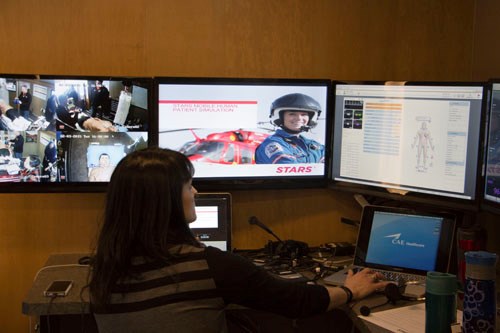In May of last year, STARS Regina unveiled a Mobile Education Unit (MEU) to be used in assisting rural communities with continuing education. Many rural health practitioners have difficulties attending sessions in Regina or Saskatoon to further their education and the STARS MEU not only provides this benefit to communities, but it also allows STARS and local hospitals to get to know each other a little bit better.
Arcola Hospital welcomed the STARS MEU on Tuesday, Feb. 3. Dr. Kish Lyster (STARS Transport Physician), Jon Antal (STARS Flight EMT), and Denise Treleaven (STARS Flight Nurse) brought the MEU out in order to run simulations with the healthcare practitioners at the Arcola Hospital.
“It’s a fantastic opportunity for us,” Dr. Lyster explained. “We get to physically see the facility, meet the healthcare providers face to face, and see what they have available to them in a rural practice.”
“It allows us to harmonize our practices and their practices. I love going on these education outings because of that.”
This theme of working together and learning more about the best practices to do that is also why the hospital staff feels it was important to have the STARS MEU come out for the day.
Manager of the Arcola Hospital, Marnell Wyatt, added, “It’s great for us to be able to meet the STARS practitioners and learn more about how STARS operates: where they can land and when. There’s a lot of working back and forth, it’s not as simple as STARS saying, ‘We’re coming.’ It takes a lot of work to put it all together.”
“Enhancing our nurses’ and doctors’ skills is essential then as we deal with a lot of motor vehicle accident patients, oil patch accidents, and heart attacks. So, this will improve our skills and our teamwork with STARS.”
Throughout the day the STARS flight practitioners hosted a total of four sessions with Arcola Hospital staff attending, some members of the Carlyle EMS, and some staff from the Redvers Hospital as well. Each session consisted of two training simulations, within each session the Arcola Hospital staff had to make decisions on how to best help the patient.
“They use their own protocols and drugs that the facility has to make the experience as real as possible,” Dr. Lyster stated.
With different healthcare professionals attending each session, the STARS flight practitioners simulated three different situations throughout the day: a heart attack, sepsis, and a patient who had been in a high-speed collision.
In each scenario the local practitioners had to respond after being given a bit of information on the patient. An example of one of these scenarios included the following:
“EMS just patched in, they have a 22-year-old male, a passenger in a vehicle which rolled at high speeds on a back grid. The driver died at the scene. The 22-year-old passenger responds to verbal stimulus and is complaining of problems breathing as well as hip and chest pain,” Treleaven described to the group. “EMS drops him off and need to get back to the scene; go.”
While working through the scenarios the practitioners were able to talk to Stan the mannequin and ask questions if the “patient” in the simulation was conscious. They also had the ability to call STARS and speak to Dr. Lyster as the STARS physician (when a real call is made to STARS a healthcare practitioner stays on the line with a STARS doctor and is patched through to the helicopter as well, so everyone is aware of real time measures taken and can collaborate in treating the patient).
As a learning tool both STARS and local practitioners found it was a beneficial day.
“This was an excellent educational opportunity,” Carol Brown, a Registered Nurse at the Arcola Hospital, stated. “STARS coming out to work with district health professionals, EMS and our hospital staff, is very beneficial. Our doctors are not always in the hospital when a patient arrives and we must respond while they’re en route. It’s always good to get upgrades and tips on what to do when someone comes into the hospital.”
Wyatt added, “They come to understand our capabilities and we understand theirs better. If a patient is injured beyond what we can do to bring them back to optimal health, then our goal is to get them stable and sent for essential life saving services in Regina.”
To those with STARS, the education moments and the ability to see the facilities across the province they are working with is essential. The MEU allows this to happen, while it also provides the local healthcare professionals and STARS healthcare professionals to get to know each other.
“It’s really important to have that interaction between rural practitioners and STARS,” Antal stated. “It’s also great to see ideas popping into their heads wherever we go and they start thinking about ‘What can we do better in our hospital?’”
Treleaven added, “It’s so nice to see those light bulbs come on when they’re in a scenario and to see the tips we’ve given them immediately used in the next scenario. We told them about passive oxygenation in one and they used it immediately in the next.”
Last year STARS responded to Arcola eight times, Carlyle two times, Kisbey once, Stoughton twice, Kenosee Lake once, Alameda once, and White Bear once.
“We are one of the busiest STARS locations in the province for a small 10 bed rural hospital,” Wyatt said. “Last summer in July, August, and September, we had the highest number of interceptions with STARS for our size.”




